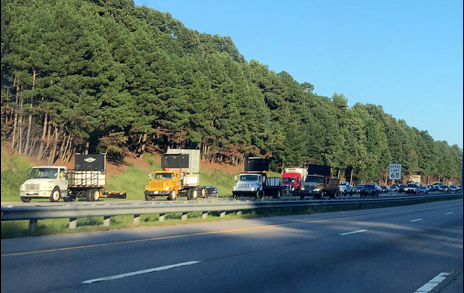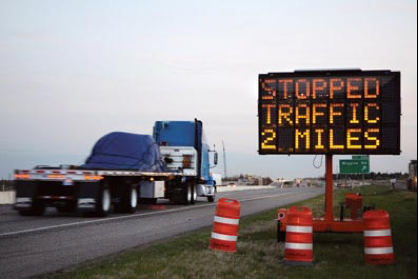Safely Implementing Rolling Roadblocks for Short-term Highway Construction, Maintenance, and Utility Work Zones
Printable Version [PDF, 648KB]
You may need the Adobe® Reader® to view the PDFs on this page.
Contact Information: Operations Feedback at OperationsFeedback@dot.gov
When safely implemented, rolling roadblocks are a highly effective traffic management technique for temporarily slowing or completely stopping traffic upstream of short-term road work activities.
What is a Rolling Roadblock
A rolling roadblock, also known as a temporary road closure, rolling block, pacing operation, or traffic pacing, is a common highway traffic control technique used to temporarily slow or stop traffic upstream of construction, maintenance, and utility work activities requiring a short-term full closure of the roadway.
Transportation agencies around the country are actively utilizing rolling roadblocks for a variety of road work activities such as:
- Bridge construction and/or replacements.
- Placing or removing overhead lights or sign structures.
- Overhead utility work.
- Blasting for rock excavation or debris removal.
Rolling roadblocks allow for faster completion of road work activities by allowing workers full access on and above a roadway, and the opportunity for a safe environment by completely removing vehicles that would normally be in close proximity to workers.

Pacing vehicles equipped with arrow or message boards and truck-mounted attenuators (TMA) safely slow and pace traffic in advance of downstream roadwork.
(Source: Raleigh News & Observer)
Safely Implementing Rolling Roadblocks
While a rolling roadblock is a highly effective traffic control technique, their use can pose safety hazards to the traveling public if not implemented safely. As a best practice, transportation agencies are encouraged to have policies and procedures in place for the safe use of rolling roadblocks. Best practices for safely implementing rolling roadblocks include:
- Developing an emergency plan for managing traffic should unforeseen circumstances occur.
- Conducting a planning meeting prior to the operation with all stakeholders, including law enforcement, utility and construction personnel, and other emergency response agencies.
- Conducting a final meeting among stakeholders before the rolling roadblock is executed to ensure all requirements have been implemented.
- Issuing press releases to radio/television stations and newspapers, and sharing plans on the agency's website and social media sites, and with third-party data providers
- Advising the public in advance as to when the rolling roadblock will be performed, including using:
- Portable changeable message signs (PCMS) to display appropriate messages to the public at least a week in advance of the roadblock.
- PCMS on the day of roadblock to alert users that the operation will be happening that day, including hours during which the roadblocks will occur.
- Any existing permanent changeable message signs (CMS) within the activity area for public notification.
- Utilizing advance warning signs and queue warning systems to alert traffic to the downstream presence of a slow or stopped traffic condition.

Advance warning signs and queue warning systems are useful in alerting traffic to downstream conditions during rolling roadblock operations.
(Source: TTI)
Example State Policies for Safely Implementing Rolling Roadblocks
Policies and procedures governing the use of rolling roadblocks for highway work activities vary by State and are typically documented in a project's Temporary Traffic Control (TTC) plan or technical specification.
The Florida Department of Transportation provides procedures for calculating the pacing distance and time intervals during which a rolling roadblock will be allowed. The agency requires that the District Public Information Office, the District Traffic Operations Engineer, Local Emergency Management Agencies, and Project Personnel be notified of the location, date, and time of an upcoming rolling roadblock at least two weeks in advance. The agency also requires that the public is notified of the upcoming operation at least one week in advance using CMS.

Existing permanent CMS in the area of a rolling roadblock operation can be used to supplement temporary public outreach tools during rolling roadblock operations.
(Source: WSDOT)
The Missouri Department of Transportation (MoDOT) utilizes a Traffic Pacing Worksheet when planning rolling roadblocks to calculate allowable pacing distance and time intervals. The agency requires the use of advanced warning signs to alert motorists of upcoming rolling roadblock operations. MoDOT also uses a Traffic Pacing CMS Layout plan detail to establish guidelines on the use of CMS and associated messages on the mainline and ramps, including alerting highway users one week prior to and during the day of the operation.
Additional Information
Additional resources are available to transportation agencies for improving rolling roadblock practices. Among these resources is Guidelines on Rolling Roadblocks for Work Zone Applications, developed by the American Traffic Safety Services Association under the FHWA Work Zone Safety Grant Program. This guide establishes best practices in the use of rolling roadblocks and provides valuable information on planning and coordinating a rolling roadblock, executing a rolling roadblock, and developing a rolling roadblock planning checklist.
This guide and other resources, including information on an available rolling roadblock training course, are available on the National Work Zone Safety Information Clearinghouse Website: https://workzonesafety.org
Resources and information on work zone management and improving work zone safety and mobility can be found through FHWA's Work Zone Management Program: https://ops.fhwa.dot.gov/wz/
For more information on rolling roadblocks and policies governing their use, contact Jawad Paracha (Jawad.Paracha@dot.gov).